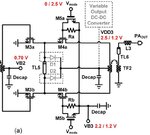Fávero Santos
Junior Member level 1

Hi, all
I saw in an article that the authors differentiate the terms stacked configuration and cascode, even though in my opinion the stacked configuration is basically a cascode configuration.
Could you please help me elucidate this issue?
The image available in the following link is a cut of the image present in the paper "A 60 GHz CMOS Dual Mode Power Amplifier With Efficiency Enhancement at Low Output Power" by Lixue Kuang, Baoyong Chi, Haikun Jia, Wen Jia and Zhihua Wang.

https://imgur.com/a/U9Ua1B5
Many thanks!
I saw in an article that the authors differentiate the terms stacked configuration and cascode, even though in my opinion the stacked configuration is basically a cascode configuration.
Could you please help me elucidate this issue?
The image available in the following link is a cut of the image present in the paper "A 60 GHz CMOS Dual Mode Power Amplifier With Efficiency Enhancement at Low Output Power" by Lixue Kuang, Baoyong Chi, Haikun Jia, Wen Jia and Zhihua Wang.

https://imgur.com/a/U9Ua1B5
Many thanks!


